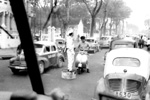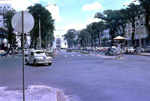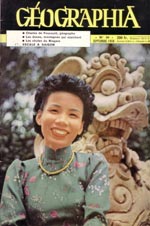
STOPOVER IN SAIGON
by Raymond Cauchetier
GÃOGRAPHIA
The article presented below was published in the monthly magazine Géographia, Number 84, in December 1958; the photos and text are by Raymond Cauchetier.
Raymond Cauchetier is one of the foremost set photographers of the "New Wave".
He is notably responsible for the famous photo of Jean-Paul Belmondo and Jean Seberg on the Champs Elysées (a photo taken âoff-setâ) as well as the one of the trio of âJules and Jimâ by François Truffaut (1961), running on a bridge.
Raymond Cauchetier is also the author of three magnificent books about Indochina: "Saigon", "Phnom Penh", and "Angkor".
Arrival in Saigon
For the traveler from Europe, the impression that Saigon leaves depends on the chosen means of transportation.
To the airline passenger the city first appears as a mere pinpoint, lost in the grey immensity of the grey peninsula of the great plain of Cochin China.
Is this microcosm really the capital of Vietnam, the city whose destiny over the years troubled the World?
The feeling is deceiving, and almost frightening. However when the airplane loses altitude, Saigon spreads out bit by bit and regains human dimensions. The layout of the city appears first as a whole, symmetrical, with its wide avenues, its green spaces, and its surrounding waterways.
Then the city itself rises up, teeming streets, the shanty towns driving their pilings out into the middle of the rivers, the markets, and the tumultuous bustle of a city where three million people live.
The steamship passenger, on the other hand, first undergoes the interminable trip up the Saigon river, the slow slalom of the liner along the thousand bends snaking their way through deserted rice paddies.
The city only appears by the tip of the bell-towers of its cathedral, rising progressively from behind a screen of vegetation. Then, suddenly, the ship emerges in the heart of the city, in the middle of the bustle of one of the biggest ports in the Far East, in a landscape of giant cranes, war ships, grand hotels, in the middle of a racket of whistles, sirens, shouts and laughter.
Asia, with care for its effect, has suddenly appeared.
The Chinese Arroyo
The Chinese Arroyo (creek) is not only a busy river, endlessly traveled by fleets of junks and sampans, but also an important artery serving as a hub for the immense network of waterways upon which the near totality of commercial transport in south Indochina takes place.
It is also an incredible floating city of several thousand people who have found an economical solution, albeit not a comfortable one, to the endemic housing shortage in all Asian cities, which is tragically without remedy due to a lack of resources of these laborious masses.
Thousands of sampans are tied up there, permanently, tangled up with each other, clogging the rice paddy to the point that there is barely enough room for a navigable channel. The river banks themselves disappear under a mound of huts on stilts reachable only by rickety bamboo foot bridges.
Despite its name, the Chinese Arroyo is mostly inhabited by Vietnamese. The Chinese have far too sharp a business sense to depend on such precarious housing.
The Pagodas
The pagodas of Saigon, and especially Cholon, which after all is just a section of Saigon, leave an unforgettable impression on those who are lucky enough to visit them. Be they Buddhist, Taoist, or dedicated to the worship of spirits, the fervor shown by the worshipers takes place in the same mystical atmosphere and the contributions of western civilizations, visible everywhere else, have not penetrated here.
On the days of traditional big festivals, the festival of wandering souls, the ceremony of Tet, etc., the pagodas are filled with a dense crowd bearing all sorts of offerings..
In the blue smoke of joss sticks, in the noise of gongs and rattles, the soul of an entire people communes in a common faith, deep, candid, and fearful.
The Cataclysms
In a few seconds, the destiny of several tens of thousands of people can be changed, and the efforts of their entire life wiped out. It only takes a tipped-over lamp, a carelessly discarded cigarette. Moments later flames arise, a column of smoke goes up and the fire takes off...
One more cataclysm to hit Saigon. Embers, carried by the wind, spread the disaster far and wide. The lightweight huts burn like kindling amidst the crackling of popping bamboo. The firefighters cannot control it. Like ants in a fire pit, they fight the flaming city in vain.
Nevertheless, the fire will go out for lack of fuel. Of the huts where thousands of families lived, nothing, absolutely nothing remains but ashes⦠A month later a new neighborhood will be rebuilt, just as lightweight, just as fragile.
And the victims of the fire will have to work for years to repay the Chinese who lent them the necessary piasters.
There is also the wrath of Nature, typhoons, thankfully rarer. When the monsoon cyclone hits a region, its merciless breath flattens forests and blows away roofs. A torrential rain falls from a black sky, and flooding is added to the destruction.
But the courage of the Vietnamese is unshaken. They will rebuild....
Portraits
I donât know who helped spread the idea that Asians, under any circumstances, remained inscrutable and did not allow their faces to express any deep feelings.
Nothing is farther from the truth, especially for the Vietnamese People, who have the vivacity, the gift of gab, and the demonstrativeness of our people of the south of France. Their gaiety, delicacy, and sense of hospitality make them infinitely likeable.
Family life
The family is the real core of Vietnamese society, as indicated by the thousand-year practice of ancestor-worship.
If parents are regarded with a respect that grows with age, children get the attention, tenderness, and general indulgence everywhere and at all times.
Street scenes
Left, a child upon whom bamboo suction cups have just been applied...
Middle, an initiation to gambling.
Right, "Cyclos".
City-dwellers are always in a hurry. The Saigonese are no exception. But since walking is hardly an attractive proposition in a town where the average temperature is 25 degrees C (80 F), they prefer to employ the services of the drivers of cyclo-pousse (human-powered cycle rickshaw) or moto-pousse (same, with engine), both mechanized versions of the early rickshaws. The unending flow of these machines runs through the streets in a din of bells. When âCyclosâ are tired they stop at one of the innumerable stalls of the mobile restaurants and while the Chinese soup is warming, they play a game of âcochoâ, where some of them will lose their earnings of the morning.
Additionally, the street offers to those who wish the opportunity to buy nearly anything.
Dentists, jewelers, doctors, fortune-tellers, grocers, beverage-sellers, and pharmacists walk around with their entire inventory hanging from the ends of their yokes.
They display their goods at places where the flow of passers-by appears to be favorable to their business.
When customers become scarce, they move on a bit. Even movie-lovers can satisfy their passion, in the street, in broad daylight, by looking into a box inside which a âPathé-Babyâ projector is running...
The Chinese city
If one encounters in Saigon numerous streets whose sole inhabitants are Chinese, the Chinese quarter, Cholon is in fact a veritable city of more than a million inhabitants.
Several years ago Cholon was famous in Southeast Asia for its gambling establishments, its sumptuous night clubs, and the picturesque night life of its streets illuminated by gigantic lighted signs.
All that has disappeared. The Diem government has imposed a politic of austerity which left only a few âpoliteâ night clubs. The Chinese signs had to come down, to be replaced with signs written in Vietnamese, and the Chinese had to give up their nationality in order to continue to do business.
But these changes didnât affect the real life, the genuine life of Cholon, which remains, today as yesterday, a Chinese city with its pagodas, its congregations, its Cantonese language, its schools, its gleaming theaters, its wonderful restaurants, and that uniqueness that makes China eternal.
Departure
This is the departure-point, across from the âPointe des Blagueursâ(Jokerâs Point), on the âMessageries Maritimesâ pier.
The steamship âFochâ is about to sail. Two thousand passengers carry with them, some with out even knowing it, the nostalgic memory of this human, brave, and smiling city: Saigon.




























































































